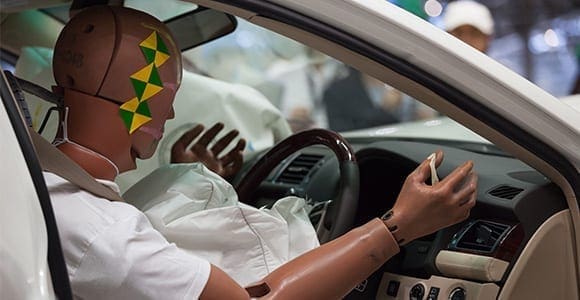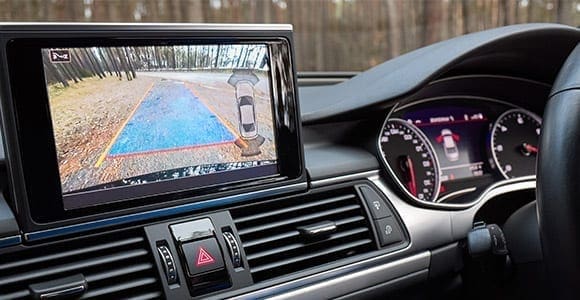- Car finance Car finance
- Motorbike finance Motorbike finance
- Van finance Van finance
- How it works How it works
- FAQs and guides FAQs and guides
- About us About us
- Home
- Blog
- Researching a Vehicle
- Car safety features
Car safety features
Updated: Tuesday, 1 November 2022
Car safety features explained
As cars continue to be one of the most popular forms of transport, it’s important that drivers and passengers feel safe and secure on the road. Modern cars have many safety features and are generally safer now than they’ve ever been. But what should you be looking for when choosing safety features for your car? On this page we explore different safety features, from the very basic right through to modern safety advancements, to help you understand what to look out for when buying a new vehicle.
Car safety features explained
As cars continue to be one of the most popular forms of transport, it’s important that drivers and passengers feel safe and secure on the road. Modern cars have many safety features and are generally safer now than they’ve ever been. But what should you be looking for when choosing safety features for your car? On this page we explore different safety features, from the very basic right through to modern safety advancements, to help you understand what to look out for when buying a new vehicle.
Car safety ratings
A car safety rating is determined from a series of tests designed to replicate real-life crash and accident scenarios. In the UK, the Euro NCAP is a common body who carry out these tests. They use a star rating of 0 – 5 to indicate how well a vehicle has performed, but the rating can also reflect the safety equipment in the car. You can research the current safety rating of the make and model of the car you’re interested in by searching on the Euro NCAP website.
Euro NCAP ratings also analyse the safety for different people associated with the car, including an adult occupant, child occupant and pedestrians – information that can be pivotal in deciding what vehicle make or vehicle type to go for depending on your circumstances and uses for the car.
The main safety features that a car must have are:
- Seatbelts
- Airbags
- Crumple zone
- Car Seats
If you’re considering a modern car with more advanced safety features, then you should consider:
- Adaptive headlights
- Brake assist
- Blind-spot warning
- Parking assist systems
- Collision avoidance systems
- Adaptive cruise control
Car safety ratings
A car safety rating is determined from a series of tests designed to replicate real-life crash and accident scenarios. In the UK, the Euro NCAP is a common body who carry out these tests. They use a star rating of 0 – 5 to indicate how well a vehicle has performed, but the rating can also reflect the safety equipment in the car. You can research the current safety rating of the make and model of the car you’re interested in by searching on the Euro NCAP website.
Euro NCAP ratings also analyse the safety for different people associated with the car, including an adult occupant, child occupant and pedestrians – information that can be pivotal in deciding what vehicle make or vehicle type to go for depending on your circumstances and uses for the car.
The main safety features that a car must have are:
- Seatbelts
- Airbags
- Crumple zone
- Car Seats
If you’re considering a modern car with more advanced safety features, then you should consider:
- Adaptive headlights
- Brake assist
- Blind-spot warning
- Parking assist systems
- Collision avoidance systems
- Adaptive cruise control
Basic safety features of a car
Whether new or old, most cars have the same basic safety features. These safety features keep the cars and their passengers safe from accidents and malfunctions which may happen on the road.
Basic safety features of a car
Whether new or old, most cars have the same basic safety features. These safety features keep the cars and their passengers safe from accidents and malfunctions which may happen on the road.
Seatbelts
Seatbelts are one of the oldest safety features in cars, though for many years they were underutilised. It only became a legal requirement to wear seatbelts in the front seats in 1983, before becoming compulsory for the rear seats in 1989. As time has gone on, seatbelt technology has evolved alongside the increasingly sophisticated vehicles they are fitted in. Smart seatbelt reminders, now installed as standard in most cars, indicate whether a passenger has done up their belt. Pre-tensioners take up all the slack in a seatbelt a split second after a crash to reduce the potential for whiplash and movement. Load limiters also reduce the amount that the seatbelt can pull across your body.
Seatbelts
Seatbelts are one of the oldest safety features in cars, though for many years they were underutilised. It only became a legal requirement to wear seatbelts in the front seats in 1983, before becoming compulsory for the rear seats in 1989. As time has gone on, seatbelt technology has evolved alongside the increasingly sophisticated vehicles they are fitted in. Smart seatbelt reminders, now installed as standard in most cars, indicate whether a passenger has done up their belt. Pre-tensioners take up all the slack in a seatbelt a split second after a crash to reduce the potential for whiplash and movement. Load limiters also reduce the amount that the seatbelt can pull across your body.
Airbags
Airbags were first introduced in the 1950s and have been a safety feature in many cars ever since. Airbags are now installed in car dashboards and the steering wheel to protect driver and passenger heads and chests in the event of a frontal crash. Knee airbags have also been developed to protect the legs and pelvis, significantly reducing the risk of a severe injury. There are also side curtain airbags that protect the heads of both the front and the rear passengers in the event of a side-on crash. Most airbags are now dual-stage airbags that inflate at different rates depending on the severity of the crash and this is all measured by sensors monitoring the deceleration rates of the car. It’s important to note that the number and positioning of airbags vary depending upon manufacturer and vehicle, so if this is something you’re worried about remember to ask the dealer or manufacturer.


Airbags
Airbags were first introduced in the 1950s and have been a safety feature in many cars ever since. Airbags are now installed in car dashboards and the steering wheel to protect driver and passenger heads and chests in the event of a frontal crash. Knee airbags have also been developed to protect the legs and pelvis, significantly reducing the risk of a severe injury. There are also side curtain airbags that protect the heads of both the front and the rear passengers in the event of a side-on crash. Most airbags are now dual-stage airbags that inflate at different rates depending on the severity of the crash and this is all measured by sensors monitoring the deceleration rates of the car. It’s important to note that the number and positioning of airbags vary depending upon manufacturer and vehicle, so if this is something you’re worried about remember to ask the dealer or manufacturer.
Stability control
Electronic stability control is one of the most important developments in car safety in recent times. It can reduce the engine power and even operate individual brakes if it detects the car starting to skid or lose control due to the driver’s inputs (anti-lock braking systems or ABS). It is now a requirement by law for all manufacturers to install this technology in all new cars. Different manufacturers refer to electronic stability control in a variety of ways, which can be confusing, so it’s worth looking up the specific name for the make you are interested in.
For information on this subject click here.
Stability control
Electronic stability control is one of the most important developments in car safety in recent times. It can reduce the engine power and even operate individual brakes if it detects the car starting to skid or lose control due to the driver’s inputs (anti-lock braking systems or ABS). It is now a requirement by law for all manufacturers to install this technology in all new cars. Different manufacturers refer to electronic stability control in a variety of ways, which can be confusing, so it’s worth looking up the specific name for the make you are interested in.
For information on this subject click here.
Crumple zone
The Crumple zone is at the front of the car and is designed to increase the amount of time it takes for a car to come to a stop following a crash. In turn, this should reduce the amount of force felt by the driver, which can majorly reduce the chance of an injury to the driver and passengers.
Crumple zone
The Crumple zone is at the front of the car and is designed to increase the amount of time it takes for a car to come to a stop following a crash. In turn, this should reduce the amount of force felt by the driver, which can majorly reduce the chance of an injury to the driver and passengers.
Car seats
Often, we’ve already got a specific, ‘favourite’ car in mind already when we start to think about a new car. However, in the current marketplace, it is really important to fully consider alternatives. There may be other models or manufacturers that you have not considered.
There are many car finder tools available which can help you find a car similar to the one you want, but at a lower cost.
When you have considered all of these questions, you are ready to make an informed choice on what car to buy and move onto the buying stage.
Car seats
Child car seats have developed hugely thanks to ISOFIX seat mounts being built into the car seats (as opposed to having to use the adult seatbelt). This makes them easier to install and is intended to reduce the risk of mistakes being made when they’re fitted.
For adult passengers, the head restraints present on car seats reduce the chance of whiplash injuries and should always be adjusted to suit the height of the driver or the passenger.
Safety features in modern cars
Modern cars have all the basic safety features, but with added features that make them even safer. Modern cars are not only more reliable than older vehicles, they are safer as well.
Some of the most common safety features of modern cars are:
- Adaptive headlights
- Brake assist
- Collision avoidance systems
- Blind-spot warning and parking assist system
Some modern cars have one or two of these features, while others have them all. When considering what car is right for you, it’s important to consider which features are most important to help you feel safe on the road.
Safety features in modern cars
Modern cars have all the basic safety features, but with added features that make them even safer. Modern cars are not only more reliable than older vehicles, they are safer as well.
Some of the most common safety features of modern cars are:
- Adaptive headlights
- Brake assist
- Collision avoidance systems
- Blind-spot warning and parking assist system
Some modern cars have one or two of these features, while others have them all. When considering what car is right for you, it’s important to consider which features are most important to help you feel safe on the road.
Adaptive headlights
Adaptive headlights are lights which adapt to corners and light up an upcoming bend in the road. More advanced adaptive headlight systems allow the lights to be adjusted as the driver steers. Some systems even utilise cameras that can detect other cars ahead, with the lights automatically adjusting to provide maximum illumination without dazzling other drivers.
Adaptive headlights
Adaptive headlights are lights which adapt to corners and light up an upcoming bend in the road. More advanced adaptive headlight systems allow the lights to be adjusted as the driver steers. Some systems even utilise cameras that can detect other cars ahead, with the lights automatically adjusting to provide maximum illumination without dazzling other drivers.
Blind-spot warning
Blind-spot warning systems work by using monitors which are fixed to the side of the car to alert the driver when another car or object is in a blind-spot. This safety feature is common in Volvos, Audis and Hyundais and is available as an optional extra on most new cars.
Blind-spot warning
Blind-spot warning systems work by using monitors which are fixed to the side of the car to alert the driver when another car or object is in a blind-spot. This safety feature is common in Volvos, Audis and Hyundais and is available as an optional extra on most new cars.
Parking assist systems
Parking assist systems are a common modern safety feature, helping drivers make parking easier.
Parking sensors – One of the most common parking assists on modern cars are parking sensors. Parking sensors are generally fixed to the bumpers and side panels of cars and send out an audio signal when the sensors come into close contact with another object.
Reverse camera systems – Reverse camera systems work by having a camera that activates when your car is in reverse gear. This shows the area behind your car on an in-car monitor, to help the driver park more easily and avoid objects that they wouldn’t be able to see otherwise.
Automated parking – The most advanced parking assist feature is the automated parking system. These systems vary depending on the vehicle, but essentially the system removes control from the driver and parks the car automatically. Utilising multiple cameras and sensors, some automated parking systems even offer parallel parking.


Parking assist systems
Parking assist systems are a common modern safety feature, helping drivers make parking easier.
Parking sensors – One of the most common parking assists on modern cars are parking sensors. Parking sensors are generally fixed to the bumpers and side panels of cars and send out an audio signal when the sensors come into close contact with another object.
Reverse camera systems – Reverse camera systems work by having a camera that activates when your car is in reverse gear. This shows the area behind your car on an in-car monitor, to help the driver park more easily and avoid objects that they wouldn’t be able to see otherwise.
Automated parking – The most advanced parking assist feature is the automated parking system. These systems vary depending on the vehicle, but essentially the system removes control from the driver and parks the car automatically. Utilising multiple cameras and sensors, some automated parking systems even offer parallel parking.
Collision avoidance systems
Automatic Emergency Braking (AEB) – Automatic Emergency Braking (AEB) is considered one of the most advanced modern safety features. The system works by automatically braking to avoid a potential collision when the driver doesn’t react in time. Some tests using AEB have shown it to react faster than humans.
Lane departure warning/lane keep – Lane departure warning systems are designed to keep a driver from drifting between lanes. The system alerts the driver when drifting out of the lane lines, and the added ‘lane keep’ system stops any drifting by automatically keeping the vehicle fixed within its lane.
Collision avoidance systems
Automatic Emergency Braking (AEB) – Automatic Emergency Braking (AEB) is considered one of the most advanced modern safety features. The system works by automatically braking to avoid a potential collision when the driver doesn’t react in time. Some tests using AEB have shown it to react faster than humans.
Lane departure warning/lane keep – Lane departure warning systems are designed to keep a driver from drifting between lanes. The system alerts the driver when drifting out of the lane lines, and the added ‘lane keep’ system stops any drifting by automatically keeping the vehicle fixed within its lane.
Adaptive cruise control
Adaptive cruise control (ACC) is essentially a more advanced version of the popular cruise control feature. ACC works by having either laser or radar signals constantly scanning the road ahead of the driver, calculating the distance to the vehicle in front, and adjusting speed accordingly to keep a safe distance. This means that if the car in front of you slows down, you will automatically slow down as well. ACC makes driving easier and matching the pace of the car in front can even save you money on fuel from unnecessary acceleration and braking.
Adaptive cruise control
Adaptive cruise control (ACC) is essentially a more advanced version of the popular cruise control feature. ACC works by having either laser or radar signals constantly scanning the road ahead of the driver, calculating the distance to the vehicle in front, and adjusting speed accordingly to keep a safe distance. This means that if the car in front of you slows down, you will automatically slow down as well. ACC makes driving easier and matching the pace of the car in front can even save you money on fuel from unnecessary acceleration and braking.
Buying a used car
When buying a used car, it’s worth checking the history of the vehicle to ensure the car has not been written off or damaged in the past. There are several services designed to ensure that you are buying a car that is roadworthy and safe. Cars should come with a full service history and extra attention should be paid to the condition of the dashboard lights, steering, brakes, headlights and tyres.
Buying a used car
When buying a used car, it’s worth checking the history of the vehicle to ensure the car has not been written off or damaged in the past. There are several services designed to ensure that you are buying a car that is roadworthy and safe. Cars should come with a full service history and extra attention should be paid to the condition of the dashboard lights, steering, brakes, headlights and tyres.
Bringing you tips on buying and maintaining your vehicle to make life on the road less stressful.
More from Moneybarn...
For a better road ahead
Moneybarn is a member of the Finance and Leasing Association, the official trade organisation of the motor finance industry. The FLA promotes best practice in the motor finance industry for lending and leasing to consumers and businesses.
Moneybarn is the trading style of Moneybarn No. 1 Limited, a company registered in England and Wales with company number 04496573, and Moneybarn Limited, a company registered in England and Wales with company number 02766324. The registered address for these companies is: Athena House, Bedford Road, Petersfield, Hampshire, GU32 3LJ.
Moneybarn’s VAT registration number is 180 5559 52.
Moneybarn Limited is authorised and regulated by the Financial Conduct Authority (Financial Services reference No. 702781)
Moneybarn No. 1 Limited is authorised and regulated by the Financial Conduct Authority (Financial Services reference No. 702780)




